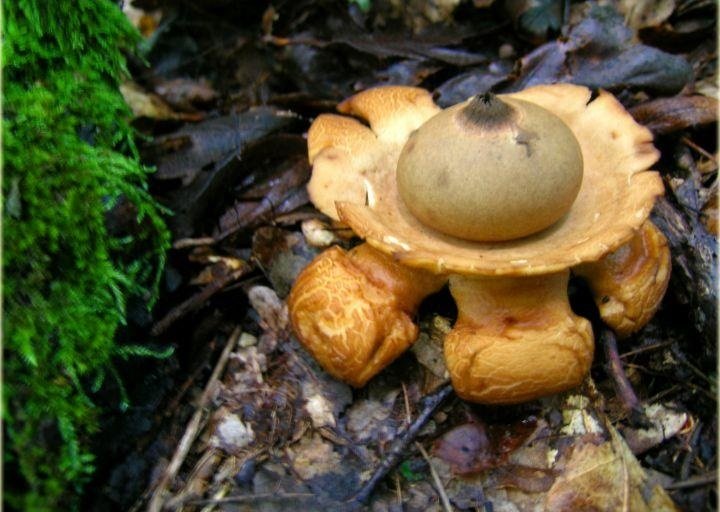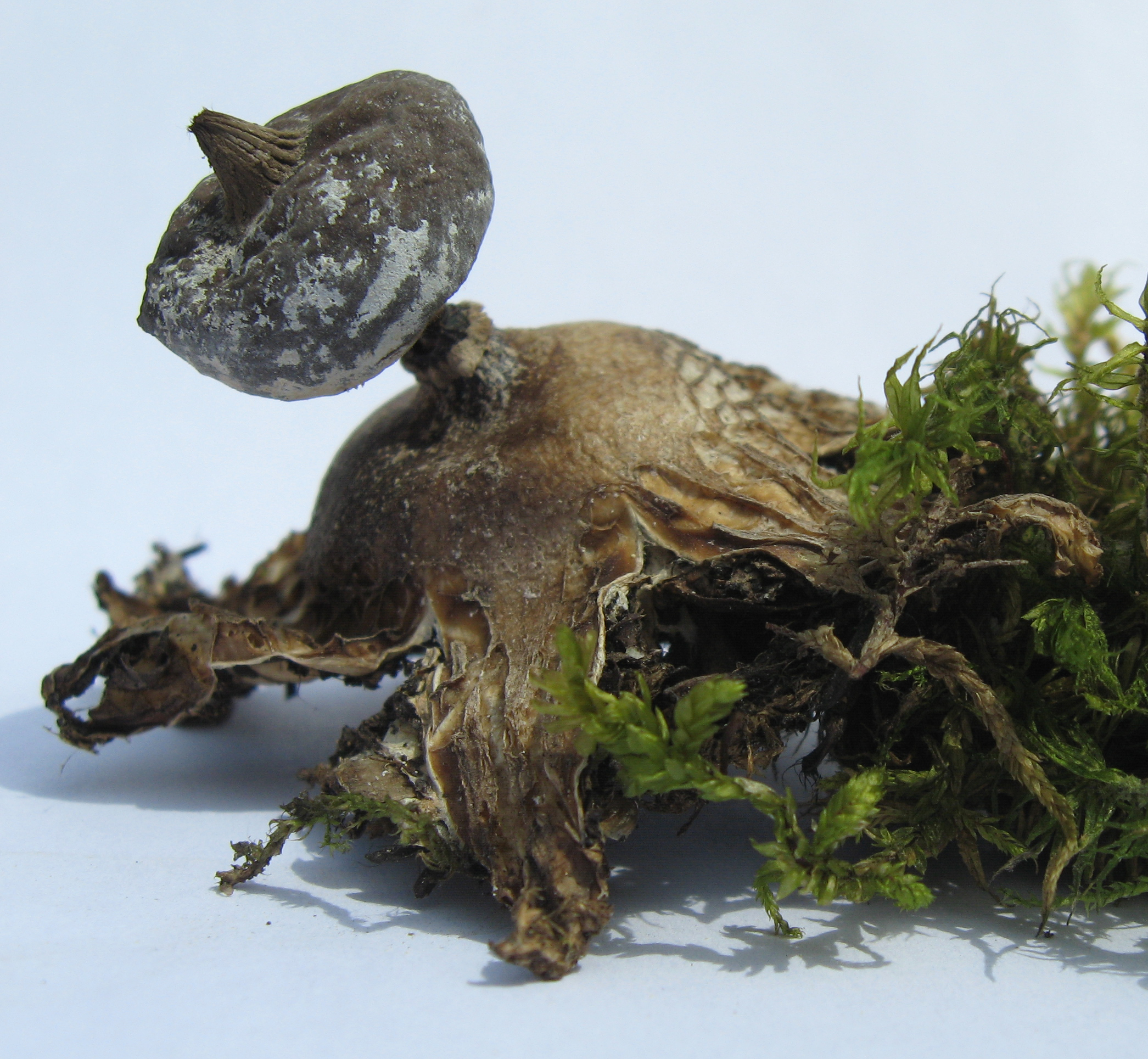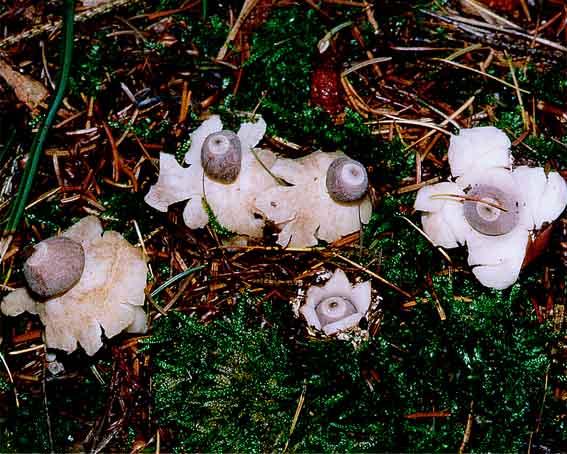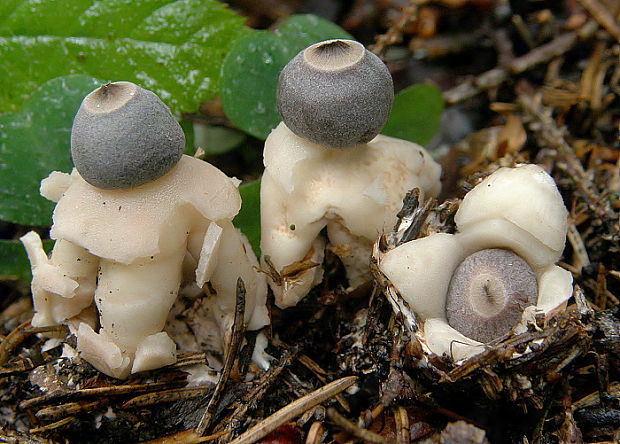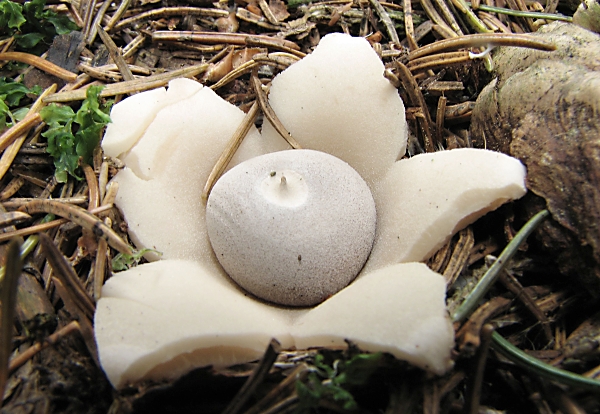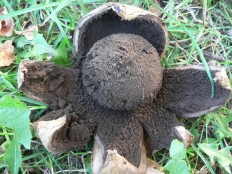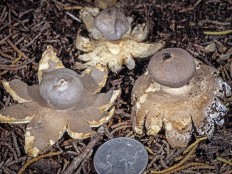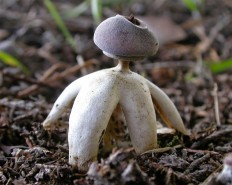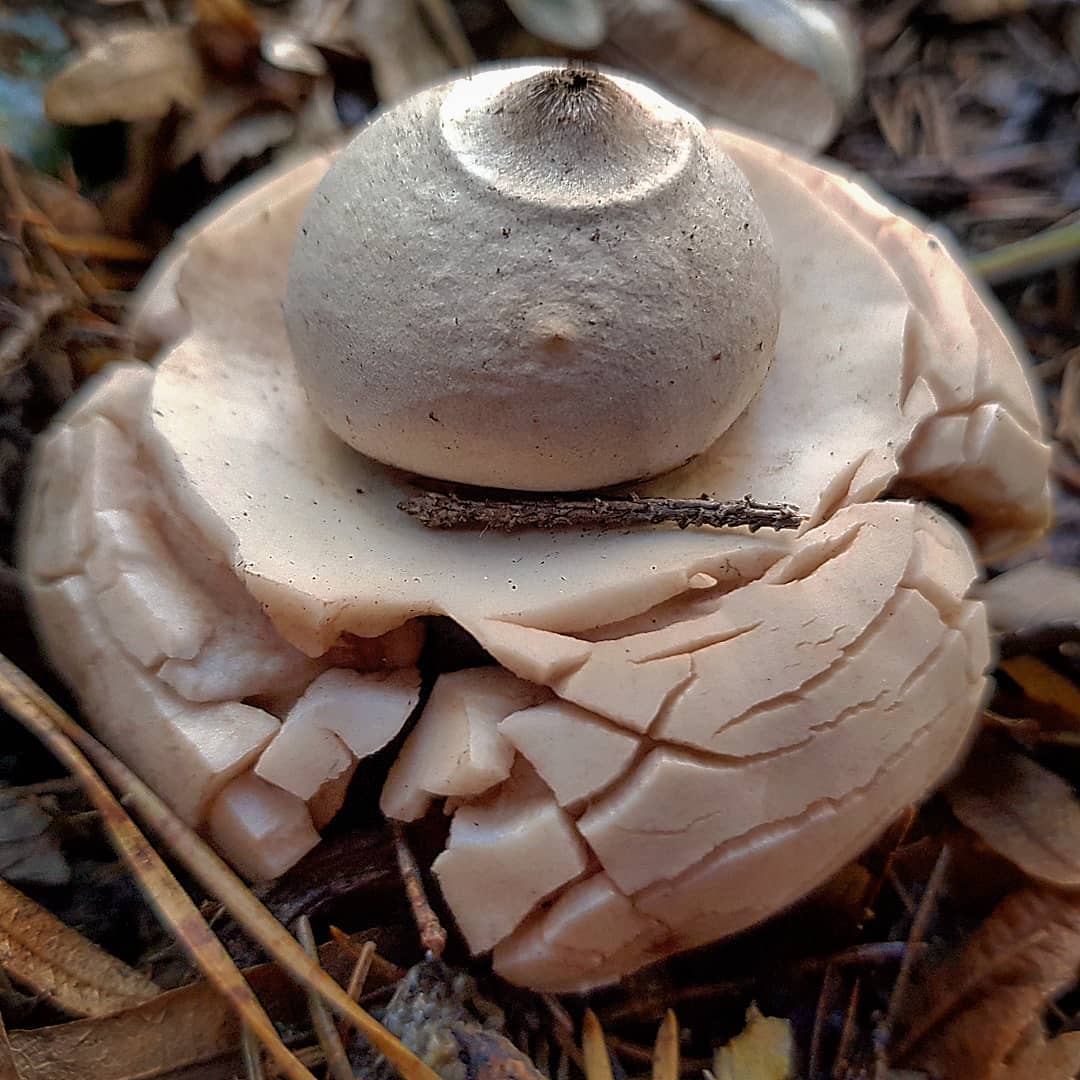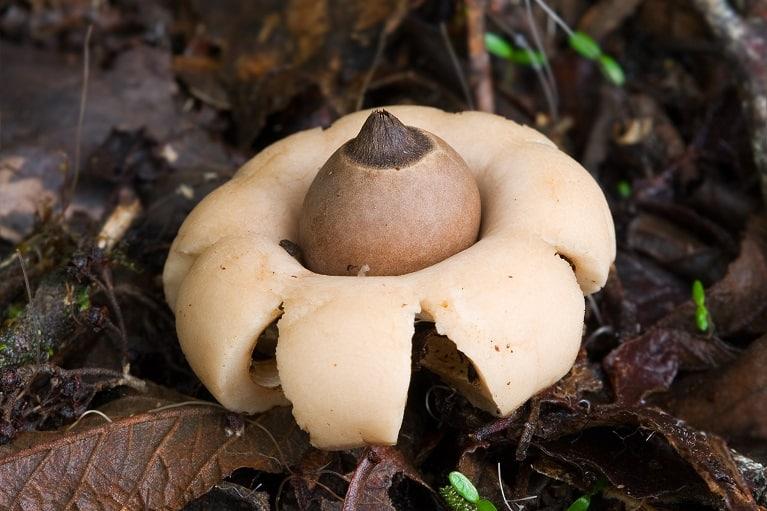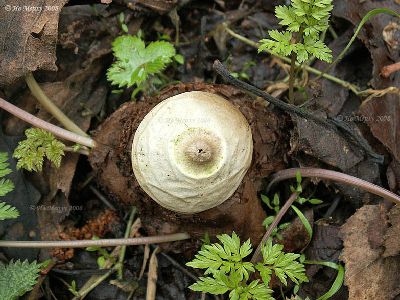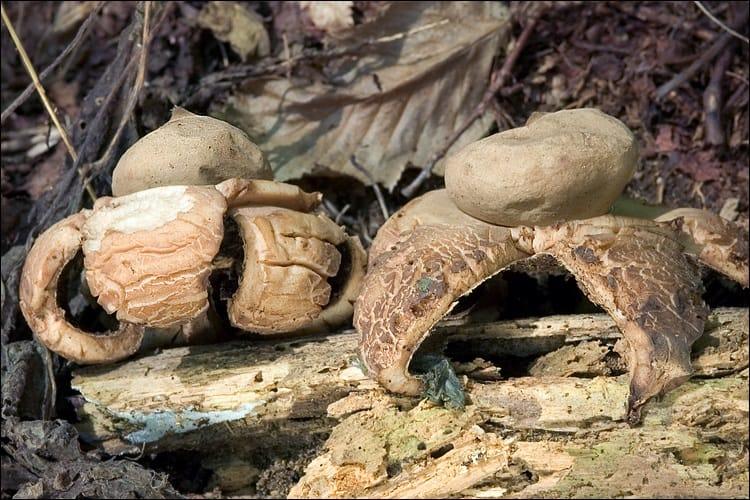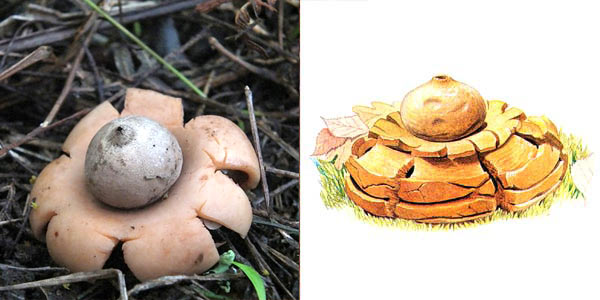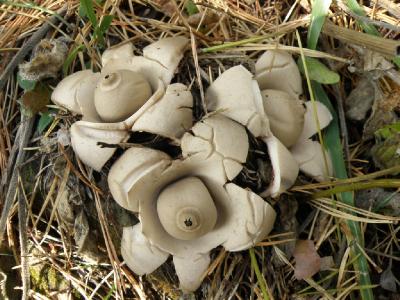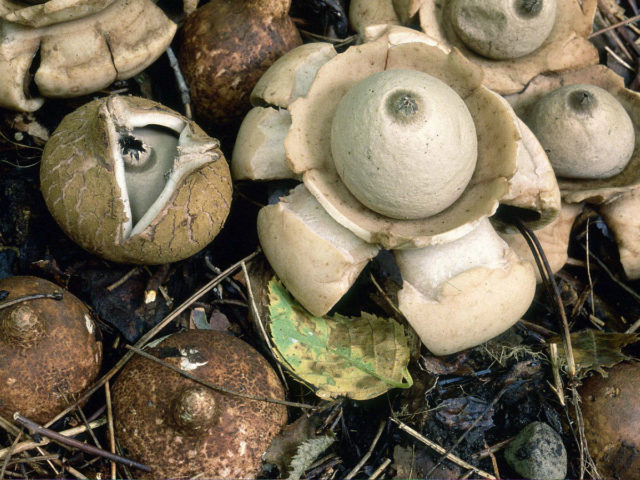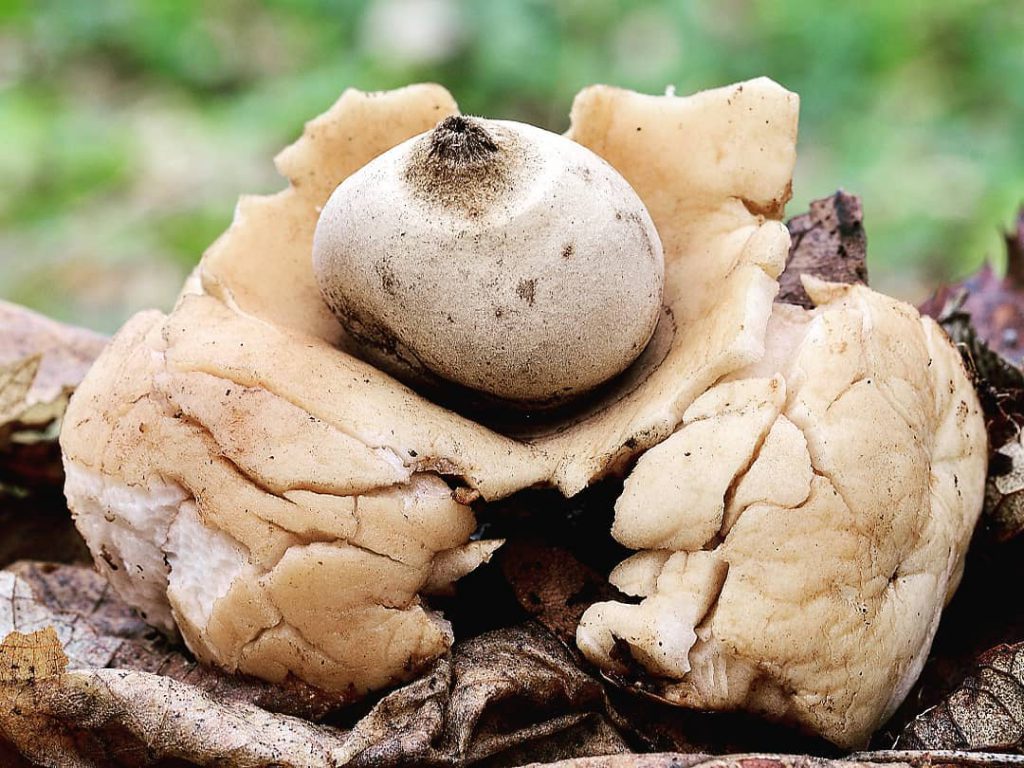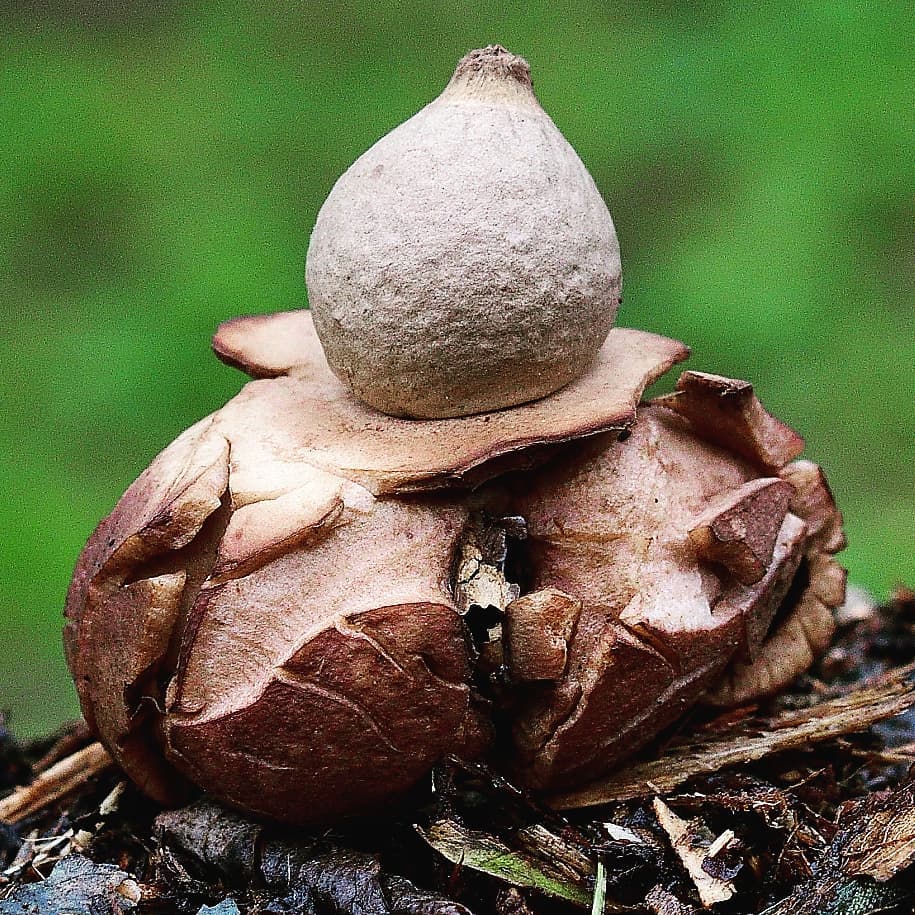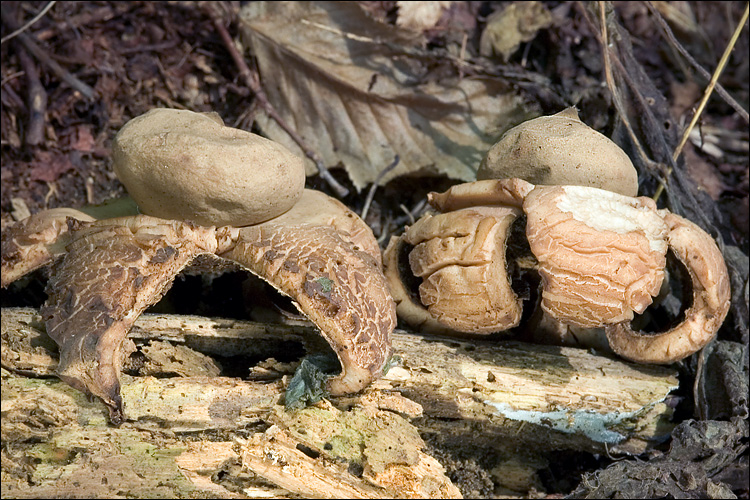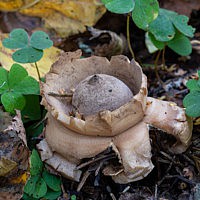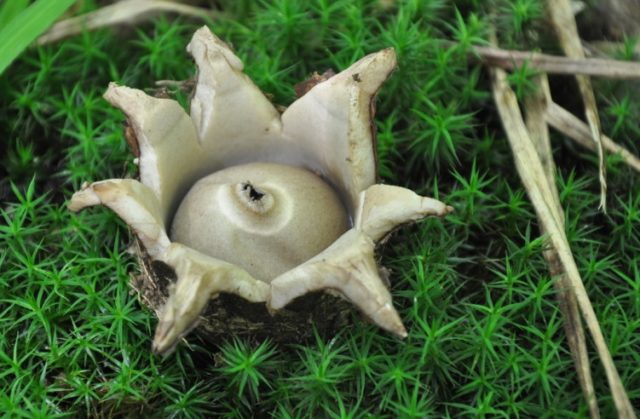Uses
Edibility
Although the fruit bodies of Geastrum triplex are nonpoisonous, they are tough and fibrous, and of "no alimentary interest". Mycologist David Arora says that they are reputed to be edible when immature — when the gleba is still white and firm — but adds that they are rarely found in this form.
In traditional medicine
Earthstars were used medicinally by Native American Indians. The Blackfoot called them ka-ka-toos, meaning "fallen stars", and according to legend, they were an indication of supernatural events. The Cherokee put fruit bodies on the navels of babies after childbirth until the withered umbilical cord fell off, "both as a prophylactic and a therapeutic measure". In traditional Chinese medicine, G. triplex is used to reduce inflammation in the respiratory tract, and to staunch bleeding and reduce swelling.
Chemistry
The fruit bodies of Geastrum triplex have been chemically analyzed and shown to contain a number of bioactive compounds, including fungal sterols such as ergosta-4,6,8, (14), 22-tetraen-3-one, 5,6-dihydroergosterol, ergosterol, and peroxyergosterol. The fungus also contains various fatty acids, notably myristic, palmitic, stearic, oleic, alpha-linolenic, and linoeic acid.
Description of triple geastrum
Outwardly, this mushroom looks like a flower. The young mushroom has a round fruiting body with a noticeable sharp tubercle. Its height can reach 5 centimeters, and its diameter does not exceed 3.5 centimeters. When the mushroom ripens, its outer layer breaks into several thick blades. The color of these blades is terracotta or beige. In this form, the diameter of the fruiting body reaches 12 centimeters.
The central inner layer of the fungus retains the appearance of a cupped collar that sits under the sessile outer layer. A hole is formed in the upper part of the fruiting body, through which ripe spores come out. In some specimens, an indentation may form around the peristome, which is slightly different from the rest of the outer layer. This area is called a courtyard. In the triple geastrum, this courtyard is wide enough and clearly visible. The courtyard is enveloped by a torn hole, which is tightly closed in young mushrooms.

If a young mushroom is cut in the middle, then in the central part of it you can see a light zone in the form of a column. The base of such a column rests against the bottom of the mushroom.
The flesh of the inner layer is juicy, soft and fragile. The flesh of the outer layer is much stronger, elastic and leathery. The inner part of the endoperidium is whole, fibrous or powdery. Spores are globular, warty, brown in color.
Distribution of triple geastrum
These flower mushrooms grow in mixed and deciduous forests. They can be found among fallen leaves and needles. They bear fruit in summer and autumn, but often fruiting bodies can persist until next year.
Geastrum triple is a cosmopolitan mushroom. These mushrooms most often grow in large groups, sometimes even hundreds of them come across. Fruit bodies can often be found at various stages of development.

Similarity of triple geastrum with other mushrooms
This mushroom has a characteristic appearance, and its fruit body opens completely, so it is difficult to confuse it with related species. But at the initial stage of growth, the triple geastrum can be confused with other large starfish.

Other members of the family
Striped Starfish is an inedible mushroom, one of the 10 most unusual mushrooms in the world. Outwardly, it resembles a large star. At an early stage, the fruiting body is underground, it has the shape of a bulb. When the mushroom grows, its outer shell breaks, leaving creamy pointed blades on the surface. Inside there is a dense spore ball, which is attached to the leg. The fruit body has a pronounced smell and taste.
Striped starfish settle on decayed tree trunks and stumps. They can be found in summer and fall. Striped starlets grow in gardens and parks They prefer ash and oak.

The four-bladed starfish is an inedible mushroom. Initially, its fruiting body is spherical, buried, with a diameter of about 2 centimeters. Mature fruiting bodies open up and their diameter becomes 3-5 centimeters. The exoperidium is three-layered, in the form of a bowl, bursting into 4 pointed lobes.
Four-lobed starfish grow on sandy soil, settling in mixed, deciduous and coniferous forests. Sometimes they can be found in abandoned anthills. Fruiting time is August-October.
Varieties
The Zvezdovik family contains a number of edible and unsuitable for culinary purposes.
Edible
The vaulted starfish, or Geastrum fornicatum, is eaten.
The fruiting body is spherical. The shade is yellow-brown. Partially buried in soil. At the stage of maturity, it cracks into curling blades. The inner part is gray, at the stage of active fruiting it becomes chocolate.
Only young mushrooms are suitable for collection.
The pulp is light; as it grows, it coarsens and turns into a dark brown spore mass.
Suitable for use at a young age, as long as the mushroom retains its spherical appearance. It is used without preliminary heat treatment.
Conditionally edible
It has a low nutritional value, does not possess a pronounced smell and taste, a conditionally edible Schmidel variety, or Geastrum schmidelii.
The diameter of the fruiting body is up to 8 cm. The shape is initially round, in a mature mushroom it is stellate inherent in the family. The spore-bearing ball is crowned with a tapered tip.
Grows on desert soils and decayed wood residues in mixed forest areas. Fruiting in August.
Inedible
- Triple, or Geastrum triplex. The shape of young fruit bodies is rounded with a pointed tubercle, similar to a bulb. Height up to 5 cm, diameter up to 3.5 cm. In a mature mushroom, the body is revealed by a two-layer shell up to 12 cm wide. The shape of the inner center is in the form of a cupped collar under a flattened outer sessile shell. The color at the stage of full maturation is beige or terracotta. Spores are globular, brown in color. The structure of the outer pulp is compacted, leathery, the inner one is fragile and soft. Grows in deciduous and mixed forest belts. Grows in large groups of coniferous and leaf litter. Fruiting occurs at the end of summer and autumn.
- Striped, or Geastrum striatum. Young, bulbous fruiting bodies are located underground. As it matures, the mushroom shell bursts, dividing the mushroom into pointed blades and a head with a granular structure and a tapered striped tip. The color of an adult specimen is milky. The spores are brown. Grows on wilderness areas, decaying stumps and tree trunks in mixed forests, park areas. More often found under oak and ash trees. Fruiting from summer to autumn.
- Crowned, or Geastrum coronatum. The fruiting body is spherical. When cracked, it is divided into sharp-pointed gray blades with a matte sheen and a central spherical part of a brown tint. Spores are dark brown. Fruiting occurs in autumn. Occurs in gardens and park areas on sandy and clayey soils among grass.
- Fringed, or Geastrum fimbriatum. Initially, the shape of the fruiting body is spherical; at the stage of maturity, the three-layer dense shell breaks into a gray spore-bearing ball and yellow-brown star-like lobes, which twist when exiting the ground. Fruiting from the beginning of August. It grows on alkaline soils in coniferous and deciduous forests in large groups, often with witch's rings.
- Small, or Geastrum minimum. It differs from all in small size. The shape of the fruit body in young mushrooms is spherical. Diameter up to 1.8 cm, unfolded - up to 3.5 cm. Color gray with beige. The apex is crowned with a conical tubercle. The spores are brown. Grows on limestones in the steppe and forest edges.
- Black-headed, Geastrum melanocephalum. The shape of young mushrooms is spherical, pear-shaped or bulbous. Width up to 7 cm. Color from milky to brown. Star-shaped blades and a spore-bearing ball with a shaggy surface. Differs in complete exposure of the gleba when the inner shell is destroyed. The pulp is initially firm, becoming fibrous and powdery as it matures, the color is dark brown. Prefers humus soils. It grows in deciduous forest belts among maples and ash trees.
- Four-lobed, or Geastrum quadrifidum. The shape of the fruiting body is initially spherical, up to 2 cm in diameter, in adulthood - up to 5 cm. The peridium consists of 4 layers. The outer mycelium is whitish with a felt structure. Medium smooth, fibrous. Inner white, in a mature mushroom, it breaks into pointed lobes and a central part that is understood upwards. Gleb powdery color, black purple or brown. Grows on sandstones in pine, spruce and deciduous forests. Fruiting occurs in August-October.
References
- Kirk PM, Cannon PF, Minter DW, Stalpers JA (2008). (10th ed.). Wallingford, UK: CABI. p. ... ISBN 978-0-85199-826-8.
- ^ Sunhede S. (1989). Geastraceae (Basidiomycotina): morphology, ecology, and systematics with special emphasis on the north European species... Synopsis Fungorum, 1... Oslo, Norway: Fungiflora. p. 535. ISBN 82-90724-05-5.
- ^
- ^
- Klotsch JF. (1832). "Mycologische Berichtigungen". Linnaea (in German). 7: 193–204.
- Rauschert S. (1959). "Beitrag zur Nomenklatur mitteleuropaischer Gasteromyceten". Zeitschrift für Pilzkunde (in German). 25 (2): 50–55.
- Mornard J. (1993). Contribution à La connaissance des champignons de Maine-et-Loire. 2-Gastéromycètes ". Bulletin de la Société Mycologique de France (in French). 109 (3): 149–63.
- Published in: Pilát A. (1958). Gasteromycetes, Houby-Břichatky. Flora ČSR B1 [Gasteromycetes-Puffballs] (in Czech). Prague, Czechoslovakia: Nakladatelstvi Československé Akademie Vĕd.
- ^
- ^
- ^ Phillips R. (2006). Mushrooms... London: Macmillan. p. 335. ISBN 978-0-330-44237-4.
- ^
- Rogers RD. (2006). The Fungal Pharmacy: Medicinal Mushrooms of Western Canada... Edmonton, Canada: Prairie Diva Press. p. 95. ISBN 0-9781358-1-4.
- ^ Foy N, Phillips R, Kibby G (1991). Mushrooms of North America... Boston: Little, Brown. ISBN 0-316-70613-2.
- ^ Smith AH. (1951). Puffballs and their Allies in Michigan... Ann Arbor, Michigan: University of Michigan Press. pp. 86-87. OCLC.
- ^
- ^ Kibby G. (1994). An Illustrated Guide to Mushrooms and Other Fungi of North America... Italy: Lubrecht & Cramer. p. 162. ISBN 0-681-45384-2.
- Ellis JB, Ellis MB (1990). Fungi without Gills (Hymenomycetes and Gasteromycetes): an Identification Handbook... London: Chapman and Hall. pp. 226-27. ISBN 0-412-36970-2.
- ^ Healy RA, Huffman DR, Tiffany LH, Knaphaus G (2008). ... Iowa City, Iowa: University of Iowa Press. p. ... ISBN 1-58729-627-6.
- ^
- Brouwer E, Braat M, van Hoek B, Noteboom R, Oplaat C, de Peijper R, Smits M, Klok P (2009). “WAD'N GEZWAM! De invloed van schelpenpaden op de paddenstoelendiversiteit van Terschelling. " Coolia (in Dutch). 52 (1): 7–17.
- Liu B. (1984). "The Gasteromycetes of China". Nova Hedwigia. 74: 1–235.
- Jung HS. (1995). Fungal flora of Ullung Island: (VI). On ascomycetous, auriculariaceous, and gasteromycetous fungi. " Korean Journal of Mycology. 23 (1): 1–9.
- Saber M. (1989). "New records of Aphyllophorales and Gasteromycetes for Iran". Iranian Journal of Plant Pathology. 25 (1–4): 21–26.
- Kose S, Gezer K, Gokler I, Tukoglu A (2006). Macrofungi of Bekilli (Denizli) district. Turkish Journal of Botany. 30 (4): 267–72.
- Cunningham GH. (1944). The Gasteromycetes of Australia and New Zealand... Dunedin, New Zealand: McIndoe. p. 201.
- Kupka J. (1966). "Geastrum triplex found in Bilina ". Mykologicky Sbornik. 43 (5–6): 83–84.
- Larsson BMP. (1958). "Gasteromycetstudier. I. Geaster triplex Jungh. funnen på Kinnekulle ”[Studies on Gasteromycetes. I. Geastrum triplex Jungh. found on Kinnekulle]. Svensk Botanisk Tidskrift (in Swedish). 52 (2): 284–90.
- Eckblad F-E. (1975). "Additions and corrections to the Gasteromycetes of the Canary Islands." Norwegian Journal of Botany. 22 (4): 243–48.
- Bottomley AM. (1948). "Gasteromycetes of South Africa". Bothalia. 4: 473–810.
- Spegazzini C. (1927). "Gasteromicetas Argentinas". Physis. 8: 421–35.
- Soto MK, Wright JE (2000). Taxonomía del género Geastrum (Basidiomycetes, Lycoperdales) en la Provincia de Buenos Aires, Argentina "[Taxonomy of the genus Geaster in the province of Buenos Aires, Argentine]. Boletin de la Sociedad Argentina de Botanica (in Spanish). 34: 185–201.
- ^ Torpoco V, Garbarino JA (1998). Studies on Chilean fungi. I. Metabolites from Geastrum triplex Jungh ". Boletin de la Sociedad Chilena de Quimica. 43 (2): 227–29.
- Tyndalo V, Rinaldi A (1985). The complete book of mushrooms... Avenel, New Jersey: Crescent books. p. 232. ISBN 0-517-51493-1.
- Hobbs CJ. (1995). Medicinal Mushrooms: An Exploration of Tradition, Healing & Culture... Portland, Oregon: Culinary Arts. pp. 19, 108-109. ISBN 1-884360-01-7.
- Ying J-Z, Xiao-Lan M (1987). Icones of Medicinal Fungi in China... Beijing, China: Science Press. pp. 527-28. ISBN 978-7-03-000195-5.
Taxonomy and classification
German botanist Franz Wilhelm Junghuhn
The species was first described scientifically, by German botanist Franz Wilhelm Junghuhn, as Geaster triplex in 1840. The earlier genus name Geaster, introduced by Italian botanist Pier Antonio Micheli in 1727 in Nova Plantarum Genera, is considered an orthographical variant of Geastrum... Junghuhn, who was living in Indonesia and extensively surveyed its fungal flora, discovered the type specimen on Mount Panggerangi on the island Java, at an elevation between 3,000 to 5,000 feet (910 to 1,520 m). Today, the type specimen is kept at the National Herbarium of the Netherlands in Leiden. The morphological feature used by Junghuhn to differentiate G. triplex from other similar earthstars was the collar-like structure of the inner layer of the exoperidium. American mycologist Curtis Gates Lloyd would later erroneously suggest that the species was a "giant form" of Geastrum saccatum.
Several authors have regarded Geastrum indicum as the correct name for G. triplex... This is because G. indicum—A species described by Johann Friedrich Klotzsch in 1832 as Cycloderma indicum and then moved to Geastrum by Stephan Rauschert in 1959 — may be the same species as Geastrum triplex... If it is in fact the same species, the first published name (i.e., G. indicum) has nomenclatorial priority according to the rules of the International Code of Botanical Nomenclature. More recently, several authors argue that G. indicum should be rejected as a nomen dubium and G. triplex maintained as the correct name for the species.
Stellan Sunhede's 1989 monograph of European species of Geastrum follows V. J. Staněk's concept for the infrageneric (below the level of genus) placement of Geastrum, and places G. triplex with species that do not incorporate and encrust forest debris (section Basimyceliata). G. triplex is further categorized in subsection Laevistomata, which includes species with a fibrillose peristome — that is, made of parallel, thin, thread-like filaments. Within subsection Laevistomata it is in stirps Triplex, due to its delimited (with a distinct restricting edge) or irregularly torn peristome.
The specific epithet triplex means "threefold", and refers to the three-layered peridium.Geastrum triplex has acquired several vernacular names, including the collared earthstar, the saucered earthstar, and the triple earthstar.
Geastrum quadrifidum
- Other names for the mushroom:
- Starfire four-bladed
- Geastrum four-bladed
Synonyms:
- Star wheel four-part
- Geastrum four-bladed
- Earth star four-bladed
Description
Fruiting bodies are initially closed, spherical, about 2 cm in diameter, covered with a peridium, along the entire surface of which mycelial strands are located; mature - open, 3-5 cm in diameter. Peridium is four-layer, consists of exoperidium and endoperidium. Exoperidium in the form of a bowl, three-layer or two-layer, hard, breaks from top to bottom to the middle into 4 unequal, pointed parts (lobes), bending down, and fruiting bodies rise up on the lobes, as on "legs". The outer mycelial layer is whitish, felt, covered with soil particles, soon disappears. The middle fibrous layer is white or isabella, smooth. The inner fleshy layer is white, also torn into 4 parts, with sharp ends resting on the sharp ends of the blades of the outer layer, soon disappears. The base is convex. The middle rises up together with the inner part of the fruiting body - the gleba. The spherical or oval (ovoid) glebe is covered with endoperidium, 0.9-1.3 cm high and 0.7-1.2 cm wide. At the base with a flattened leg, above which the endoperidium is narrowed and a well-visible rounded protrusion (apophysis) is formed, at the apex it opens with an opening, which is equipped with a low peristome. The peristome is conical, fibrous, with a sharply limited courtyard, smoothly fibrous-ciliate, around which there is a clear ring. The stem is cylindrical or slightly flattened, 1.5-2 mm high and 3 mm thick, whitish. The column is cotton-wool, light brown-gray in section, 4-6 mm long. Its exoperidium ruptures more often by 4, less often by 4-8 unequal pointed lobes, bending downward, which is why the entire fruiting body rises up on the lobes, as on legs.
The leg (in the traditional sense) is missing.
Gleba is powdery when ripe, black-purple to brown. Spores are brownish, light or dark brown.
When pressed, the spores fly in all directions. Spores are olive brown.
HABITAT AND GROWTH TIME
The four-part starfish grows mostly on sandy soil in deciduous, mixed and coniferous - pine, spruce, pine-spruce and spruce-deciduous forests (among fallen needles), sometimes in abandoned anthills - from August to October, rarely. Recorded in Russia (European part, Caucasus and Eastern Siberia), Europe and North America.We found it southeast of St. Petersburg in a mixed forest (birch and spruce) under an old spruce on needles in early October (the mushrooms grew as a family).
TWINS
The four-part starfish is very peculiar in appearance and is strikingly different from mushrooms of other genera and families. It is similar to other starfish, for example, to the Vaulted starfish (Geastrum fornicatum), whose exoperidium splits into two layers: the outer one with 4-5 short, obtuse lobes and the inner, convex in the center, also with 4-5 lobes; on Zvezdovik crowned (Geastrum coronatum) with leathery, smooth exoperidium, splitting into 7-10 gray-brown pointed lobes; on Fringed Starfish (Geastrum fimbriatum) with exoperidium, which is torn by half or 2/3 - by 5-10 (less often up to 15) unequal blades; on Zvezdovik striped (G. striatum) with exoperidium, bursting into 6-9 lobes, and light gray gleb; on the small Starfish Shmiela (G. schmidelii) with exoperidium, forming 5-8 lobes, and a gleba with a beak-shaped grooved striped nose; on Zvezdovik triple (Geastrum triplex) with a fibrous hole at the top of a gray-brown block.
It is confined to the soils of deciduous and coniferous forests.
Habitat and distribution
Stages of fruit body emergence
Geastrum triplex is a saprobic fungus: it derives nutrients from decomposing organic matter. The fruit bodies are usually found growing singly or more commonly in groups in hardwood forests where much humus has accumulated; in Mexico, they have been collected in tropical deciduous forest. Fruit bodies are often found around well-rotted tree stumps; they are initially almost buried in the loose duff, but emerge during maturity as the downward curling of the rays exposes the spore sac. Old fruit bodies are persistent, and may survive the winter to be found the following spring or summer. A Dutch study reported a propensity for G. triplex to grow on soil made calcium-rich from washed-out chalk of crushed shells on bicycling paths. It is described as common in North America and Europe. One author states it is commonly found under beech trees.
Geastrum triplex has a widespread distribution, and has been collected in Asia (China, Korea Iran, and Turkey), Australia, Europe (Belgium, Czech Republic, Sweden, and the Canary Islands), and Africa (Congo, South Africa). In North America, its range extends north to Canada and south to Mexico, including the whole continental United States and Hawaii. In Central and South America the fungus has been reported from Panama, Trinidad and Tobago, Argentina, Brazil, and Chile.

